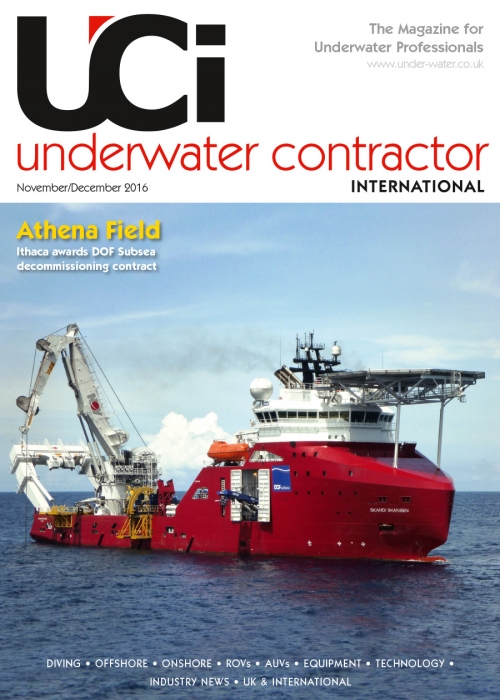
The Magazine for Underwater Professionals
![]() Nov/Dec 2014
Nov/Dec 2014
INDUSTRY NEWS - OPERATIONS
N-Sea completes inaugural TUP system diving scope
N-Sea, the Netherlands-based inspection, maintenance and repair specialist, has completed its inaugural diving scope with the TUP Diving System.
The diving scope involved Christmas tree assistance with the deployment of the TUP Diving System for Oranje-Nassau Energie (ONE), the largest privately-owned Dutch operating company, on its ‘L6 Diving Services’ project at location L6D in the North Sea.
BUILT
The TUP Diving System has been designed and built in-house by N-Sea, and comprises a three-man bell, launch and recovery system, triple lock decompression chamber, gas diver control (air/trimix/nitrox) and hyperbaric rescue craft. Over the last year the system has undergone a complete refit and has been converted to allow it to be used as a mobile system, deployable from most DP2 support vessels and platforms.
Gerard Keser, chief executive officer of N-Sea, said: “The TUP Diving System enables N-Sea to offer a safe, complete and very cost effective solution to customers. The system is safe, because there is no surface decompression interval and the system allows protected transfer through the splash zone. It’s an enhanced proven solution that increases the workable bottom time.”
Theo Bergers, Oranje-Nassau Energie’s chief operating officer, added that “key factors for choosing the TUP Diving System were safety and workability”.
Aberdeen, UK-based Fugro Subsea Services Ltd (FSSL) has successfully completed the trenching and burial of inter-array cables for CT Offshore, Denmark, at the Gwynt y Môr wind farm in the Irish Sea off the North Wales coast.
The 160-turbine Gwynt y Môr is currently the largest offshore wind farm under construction in Europe.
PERFORM
Central to the success of the cabling operation was Fugro’s custom-built Q1400 trenching system which can perform both jet trenching and mechanical chain cutting of soils. In total, 37 cables were trenched into very hard seabed with a mixture of soils and hard clays interspersed with boulders and cobbles, gravels and sand. Despite these demanding conditions the Q1400 was successful in burying all the cables.
“The Q1400 has the manoeuvrability and compact size to be able to trench right up to the cable j-tube, or in this case the cable protection system, which minimised the need for rock dumping or matressing, potentially saving on cost,” said Mike Daniel of FSSL.
SECOND
Gwynt y Môr is the second wind farm project where the Q1400 trenching system has been used when soils have been beyond the capabilities of standard jet trenching systems, and this follows on from a busy 2013 with completion of four successful oil and gas trenching projects, one off the west coast of Ireland and three in the North Sea.
“We have experienced outstanding cooperation with the Fugro team throughout the Gwynt y Môr project,” said Jimmy Laursen, project manager at CT Offshore. “We met many challenges, especially with the demanding soil conditions on the GyM project. With Fugro as our trenching partner, we were able to overcome these challenges and accomplished the installation and burial of the inter-array cables in the safest and most efficient way.”
Hibbard Inshore, USA, has set the record for the longest flooded tunnel inspection against flow ever attempted. Success came from using the Saab Seaeye, UK, Sabertooth AUV/ROV hybrid.
Used as a tethered ROV, which was extremely important to Hibbard for real-time data feedback, vehicle control and safety measures, the Sabertooth swam the eight kilometres of tunnel against a 0.3 kilometre-per-second flow whilst fitted with a range of surveying and filming systems.
This achievement kept the vital water supply flowing to Rio Tinto’s, UK, aluminium smelting plant in British Columbia, Canada, during the inspection mission.
Speed was essential as the flow was reduced during the mission and a “very fast” inspection in an eight-hour timeframe was needed, said Dave Malak, director of Hibbard Inshore.
The Sabertooth was fitted with a combination of multibeam systems and cameras to provide 3D profiling of the tunnel, along with a record of the tunnel wall status and HD video examination of areas of concern.
For Rio Tinto, the 40 year-old tunnel is a critical asset that needed a thorough examination to reveal areas of potential collapse for maintenance planning and to provide comparable data for trends in tunnel condition.


